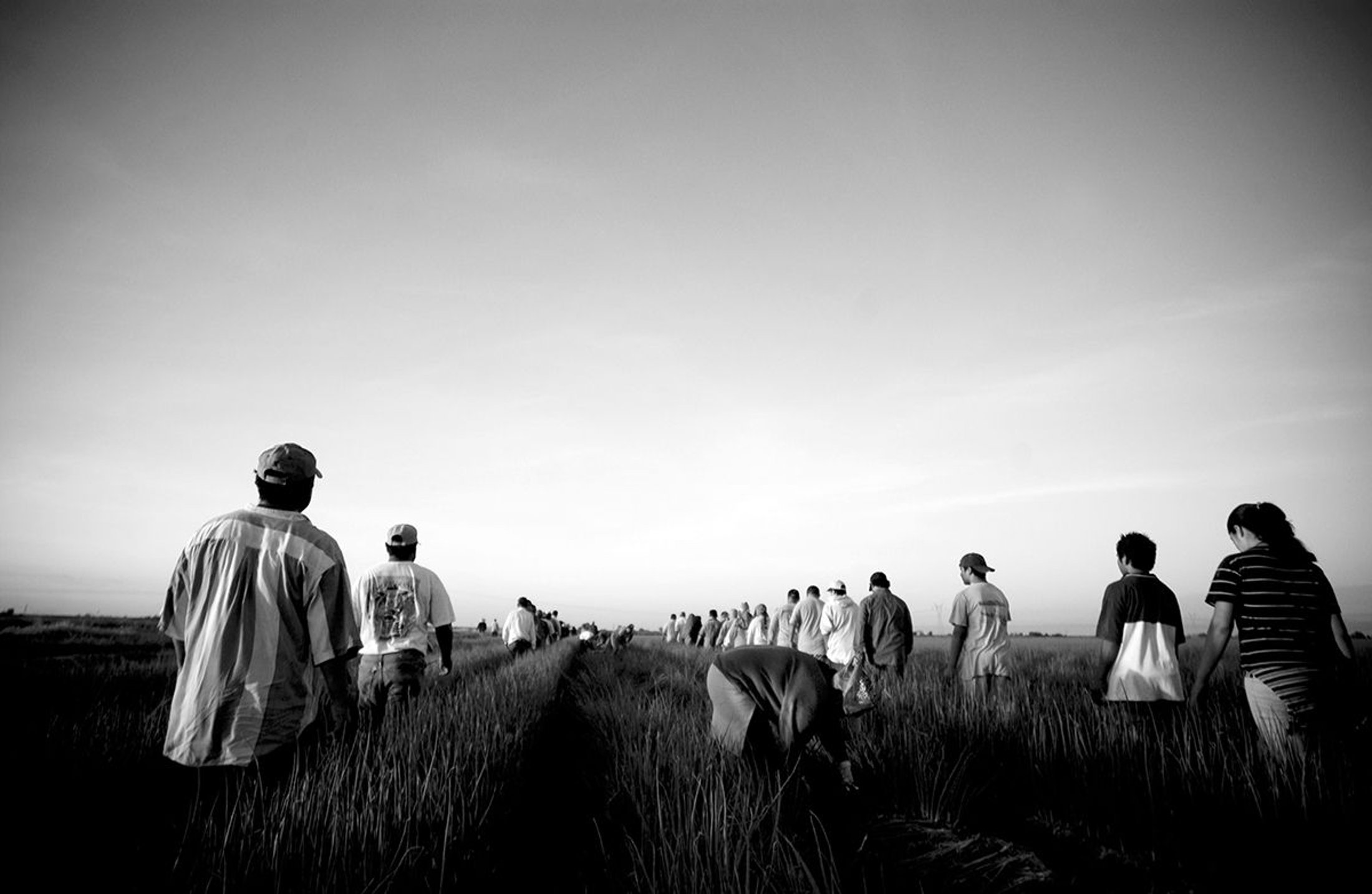Field workers walk in single file lines to take their positions in a field of green onions as they begin their day's work. Workers such as these begin their day at 4:00am. They have their breakfast in the field. Most will work a full 10-hour day bundling green onions by hand. The price of their work is easily quadrupled by workers picking the exact same crop in American fields just an hour's drive north across the border. Ejido Hermosillo, Sonora, Mexico, August 29th. © Brandon Thibodeaux
An elderly woman gathers green onions for harvest. Ejido Hermosillo, Sonora, Mexico, August 29th. © Brandon Thibodeaux
The wife of a small landowner sits with her granddaughter outside their home near the border town of San Luis Rio Colorado, Mexico. The Rio Colorado lies less than one mile from this family’s home. Due to heavy use by the US, the mighty river crosses into Mexico as little more than a large cement-lined drainage ditch used to irrigate northern Sonora's farmland. Ejido Hermosillo, Sonora, Mexico, August 25th. © Brandon Thibodeaux
Village residents play football in the streets. Ejido Hermosillo, Sonora, Mexico, August 27th. © Brandon Thibodeaux
A village resident plays his guitar in the late afternoon following a day of field work. Ejido Hermosillo, Sonora, Mexico, August 28th. © Brandon Thibodeaux
A local farmer dances with a prostitute in a bar. The bar is operated by the ejido [a piece of communally farmed land supported by the state], and proceeds from beer sales go toward running the ejido's school buses and water truck. Ejido Hermosillo, Sonora, Mexico, August 27th. © Brandon Thibodeaux
A migrant and her son from Jacaleapa, Honduras, sit for a portrait at the Senda de Vida migrant house. The two have been at the migrant house for a month. She left because of poverty—there was no work in her town—leaving one daughter behind. "Sometimes when people gave him food on the bus ride up I would tell him to say thank you but with a knot in my chest." Reynosa, Mexico, August 22nd. © Brandon Thibodeaux
An unidentified man is seen climbing over the international border dividing Mexicali, Mexico, from Calexico, California. His two comrades steady a handmade ladder. Mexicali, Sonora, Mexico, September 16th. © Brandon Thibodeaux
Members of the Texas Border Volunteers walk around a known resting place used by migrants. Falfurrias, TX, March 28th. © Brandon Thibodeaux
Alonzo Rangel of Funeraria del Angel Howard-Williams hands over what will later be determined to be a fake Mexican identification card to a border patrol agent as he inspects and covers the body of a deceased migrant. The man's wife reported his death by way of a 911 call when she and five other immigrants broke away from a larger group of 20 crossing through a Brooks County ranch on Sunday morning. This is the 48th body discovered in Brooks County this year. Falfurrias, TX, August 18th. © Brandon Thibodeaux
A group of male migrants is led to a Border Patrol transport unit on a ranch. Falfurrias, TX, March 27th. © Brandon Thibodeaux
Mark Hnatiuk, a member of the Texas Border Volunteers, stands around Border Patrol vehicles after helping the Border Patrol locate migrants making their way north. Falfurrias, TX, March 27th. © Brandon Thibodeaux
Border Patrol agents detain a group of migrants that were making their way towards the US through a nearby ranch. Falfurrias, TX, March 27th. © Brandon Thibodeaux
An airplane spotlight can be seen in the night sky as border patrol agents detain a group of northbound migrants. Falfurrias, TX, March 27th. © Brandon Thibodeaux
A Border Patrol agent loads a group of migrants that were detained by the Brooks County Sheriff's Department into his transport truck at the Sheriff's Department headquarters. Falfurrias, TX, March 27th. © Brandon Thibodeaux
Diana Guel, 24, stands overlooking her 14-month-old daughter, Jennifer Martinez, and other neighborhood children at the doorway of her apartment. Guel migrated to the U.S. three years ago from the Mexican city of San Luis Potosi. Like many young women who migrated to Irving, she works as a cleaning woman for businesses in the city. Irving, TX, February 7th. © Brandon Thibodeaux
Hispanic students at Gilbert F. M. Elementary School participate in their fifth grade math class. Gilbert Elementary falls above the Irving School District's 2008 average for Hispanic enrolment, with 83.8 percent of its 770 children being Hispanic. In the fall of 2008, 70 percent of the students who enrolled in kindergarten through fifth grade in Irving's schools were Hispanic, and 56 percent of the students in those grades were classified as English language learners. Irving, TX, February 3rd. © Brandon Thibodeaux
Day laborers gather near a well-known "work corner." The men gather seven days a week, pacing the parking lot, or conversing in small huddles, all the while keeping an eye out for sign of a slowing truck or car holding the promise of work. Most claim that they stand to make an average of $80 a day, though they're lucky if they get picked up more than twice a week. Irving, TX, February 9th. © Brandon Thibodeaux
Eduardo Canales is the organizer for the South Texas Human Rights Center. The organization aims to end death and suffering among migrant border crossers. Their efforts include maintaining water stations along known migrant trails in Brooks County. Falfurrias, TX, August 19th. © Brandon Thibodeaux
Sophia Buenrrostro cries as she tells the story of how her husband, George Buenrrostro, was caught and deported while working out of town in Abilene, TX. With no other family nearby, Sophia, a U.S. citizen from Oregon, and 30 year old mother of two, is now forced to work at two different lavanderias to raise her son and daughter. "My son, who shares the same name as his daddy, sometimes asks me why I can't give his birth certificate to his father so he can come back to us. My babies are always asking me why he's not at home," Buenrrostro said. Buenrrostro is one of thousands of women in the U.S. who was turned into a single mother as a result of having a husband deported. Irving, TX, February 3rd. © Brandon Thibodeaux
Lori E. Baker, Ph.D., a forensic anthropologist with Baylor University examines the skull from what is assumed to be the skeletal remains of an unidentified migrant found on a ranch in Brooks County, TX. Dr. Baker is the Founder and Executive Director of the International Consortium for Forensic Identification's Reuniting Families Project. Waco, TX, August 21st. © Brandon Thibodeaux
A sign reading "bones" serves as a marker for the grave of unidentified migrant remains that are buried in Brooks County's cemetery. In 2012, the remains 127 migrants were discovered in Brooks County, which is nearly 60 miles north of the Mexican border with Texas. It is considered to be the last stop before illegal immigrants make their way to larger cities like Houston. Judge Raul M. Ramirez says that the county has run out of room to bury future unidentified remains, a task that places an even tighter strain on the already stressed county budget. Should the rising trend of migrant death continue, the county will be forced to acquire more land for a new cemetery. Falfurrias, TX, February 27th. © Brandon Thibodeaux




